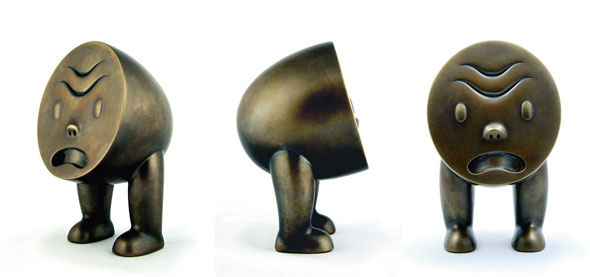
Gary Taxali Interview
Gary Taxali's one man show, 'Last Year's Winner', opened last night at Magic Pony. Mr.Taxali has long been a star in the field of commercial illustration and has shown his work in galleries through out North America. However with last night's huge turn out, his recent dabbling in toy design and the creation of his own children's book, Gary Taxali seems to reaching out to a wider audience. He answered a few questions for me before last night's opening.
Q: You've been involved with Magic Pony for a while. Do you pay much attention to the Toronto art scene? Is maintaining an artistic presence here important to you?
A: I try and pay attention to the Toronto art scene. One, because I live here, and two because I think there are so many amazing artists here. I feel fortunate to live in a city where so many people are doing cool things and there are lots of great events to bring these cool things to the public light. Magic Pony has become my HQ in Toronto. It's nice to feel appreciated in the place that you live. I'm not used to that. One of the problems that I do have with the Toronto art scene is that it is very fragmented. I still think there exists too many insular groups that would have a greater impact if they figured out a way to come together. In 1991 a group of people started Roundup, (a venue for artists not represented by galleries who could show their work in bars, restaurants and their own studio spaces). Things like Roundup need to start happening again, because many artists will find camaraderie in other places , and this is the reason why so much talent leaves the city. It really doesn't need to be this way.
Q: What impact do you feel the release of your 'Toy Monkey', children's book: 'This Is Silly' and continued gallery exhibitions have on your commercial illustration career?
A: All of those things are an extension of my career. I think it's good to explore areas of interest that one has, and illustration serves as a perfect vehicle to make these things happen. Through the world of illustration, one can build a name and resources to help facilitate other projects. I have been asked to participate in gallery shows. From there, that led to creating designs for toys, and eventually creating my own toys. Like they say, you open one door and it leads to others. And of course, illustration can be financially lucrative enough for a person to make investments in these areas. And taking a chance is what it's all about.
Q: Do you see yourself moving more into the realm of fine art and away from commercial illustration in the future? Is there any difference for you?
A: That is a really good question. It's something I've been thinking about a lot. And yes, I can see myself doing that. However, even in my fine art work, I'm constantly telling stories, and that always brings me back full circle to illustration. I'm a born illustrator and I cannot deny that. I think labels are unimportant. What is important is that you do the work that you love and for me 50% of the time that work ends up on walls of a gallery, and the other 50% of the time it ends up on magazine pages. I feel lucky to have both.

Q: Could you name drop a few of your artistic influences - I remember you playing that Japanese kid's show at OCAD a few years ago. What was the name of that again?
A: That TV show was called Kure Kure Takora (Gimme Gimme Octopus), one of the most strange and beautiful television shows I've ever seen. In terms of artistic influences, I would have to say my friends are the people that inspire me the most. But here in the Toronto scene, there are some killer artists who are doing some amazing work like Michael Comeau, Team Macho, Chris Hutsul, Andrew Wilson, Melinda Josie, Fiona Smyth, Kevin McBride - I really enjoy what they're doing.
Q: Could you talk a bit about your lecture at the Danish Design school in Copenhagen last May?
A: That was a very interesting experience. I was intrigued by how unpretentious the Danish were, and everything was about the greater good of society. Design and fine art reflected this very well. It is an ethnocentric society, and illustrators don't think about having a career outside the borders of Denmark. It is a very inspiring society. The students are immensely talented. Then again, out of thousands of applicants, there are only 30 selected each year.
Q: What advice would you offer to younger artists in Toronto?
A: Perseverance is very important. Keep working hard on the things that you love to do. Above all, maintain connections within your community. The support of other people in the business is paramount. Oh yeah, and don't eat yellow snow.
*'Last Year's Winner' runs at Magic Pony until Sept.30th
*Photos taken by Richelle Forsey
Latest Videos
Latest Videos
Join the conversation Load comments







